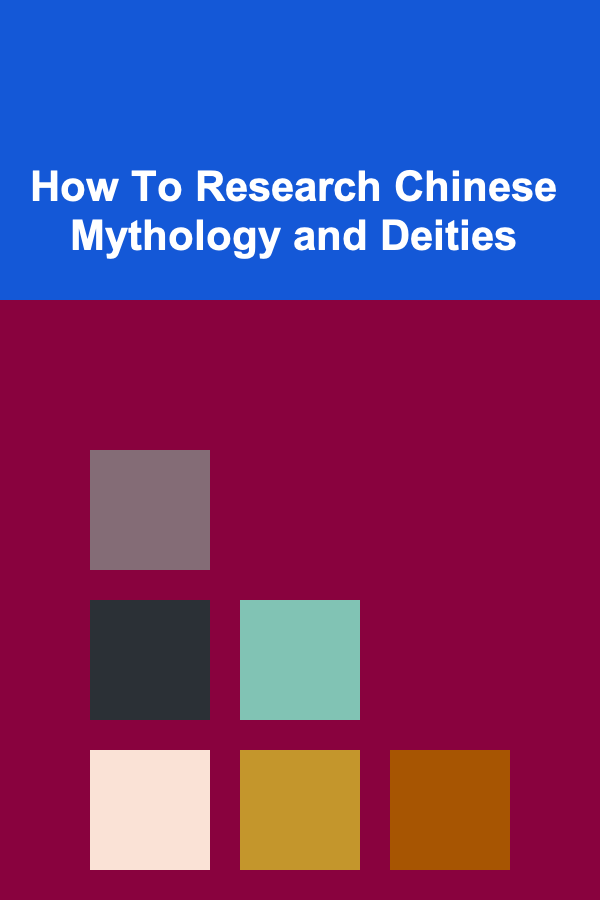
How To Research Chinese Mythology and Deities
ebook include PDF & Audio bundle (Micro Guide)
$12.99$10.99
Limited Time Offer! Order within the next:

Chinese mythology is a vast and rich tapestry, woven with thousands of years of history, folklore, and cultural evolution. At the heart of Chinese mythology lie its deities, each with its own unique story, powers, and symbolic meanings. Understanding Chinese mythology and its pantheon requires not only a broad knowledge of ancient texts and oral traditions but also an appreciation for the cultural and philosophical contexts that have shaped these myths over time. In this article, we will explore how to research Chinese mythology and deities, offering both traditional methods and modern tools for delving into this fascinating subject.
Understanding the Foundations of Chinese Mythology
Before diving into research, it's essential to understand the basic structure and themes of Chinese mythology. Unlike the myths of the ancient Greeks or Romans, Chinese mythology is not a singular, unified narrative but a diverse collection of stories that span different regions, dynasties, and philosophical schools of thought.
Chinese mythology often blends elements of folklore, religious beliefs, and historical events. The deities in Chinese mythology are deeply intertwined with Taoism, Confucianism, and Buddhism, each bringing a different lens through which to interpret the myths. Some gods represent natural forces, while others embody virtues or moral lessons.
Key Texts in Chinese Mythology
Several foundational texts are crucial for understanding Chinese mythology:
-
The Classic of Mountains and Seas (山海经, Shanhai Jing)
One of the earliest and most important texts in Chinese mythology, this compilation of myths, geographical accounts, and legends provides a wealth of information on ancient Chinese cosmology, deities, and mythical creatures. Although it is not a structured religious or philosophical work, it offers valuable insight into how ancient Chinese people understood the world and the divine.
-
The Book of Changes (易经, Yijing)
While primarily a text of divination and philosophy, the Yijing (or I Ching) contains significant mythological elements. It includes references to the cosmic forces that shape the universe, which are integral to understanding Chinese thought about deities and their roles in human affairs.
-
Taoist Texts
Taoism, a key philosophical and religious tradition in China, has a rich body of sacred texts that feature a pantheon of deities, each with distinct functions. The Tao Te Ching by Laozi and the Zhuangzi by Zhuang Zhou explore the relationship between humanity, nature, and the divine.
-
Buddhist Texts
Buddhism, which entered China from India, merged with Chinese traditions to create a hybrid religious landscape. Buddhist texts, such as the Lotus Sutra and the Avatamsaka Sutra, contain numerous deities and celestial beings who became part of the broader Chinese mythological framework.
Key Themes in Chinese Mythology
- Creation and Cosmology : Chinese mythology offers various creation myths, such as the story of Pangu , the giant who separated heaven and earth, and the myth of Nüwa, the goddess who repaired the sky.
- Immortality and the Afterlife : Many Chinese myths focus on the pursuit of immortality, with deities like the Eight Immortals (八仙, Baxian) embodying the ideals of longevity and transcendence.
- The Natural World : Many deities in Chinese mythology personify natural elements like rivers, mountains, and celestial bodies. The Yellow Emperor (黄帝, Huangdi), for example, is not only a legendary ruler but also a symbol of the unity between humankind and nature.
- Moral and Ethical Lessons: Chinese mythology often carries moral lessons. Many of the stories feature gods and heroes who embody Confucian virtues, such as filial piety, righteousness, and humility.
Primary Sources for Research
Once you have an understanding of the foundational texts and themes, it's time to start gathering primary sources. These are the core texts and artifacts that directly relate to Chinese mythology and deities.
Classical Texts and Anthologies
- Annotated Translations: Given that most of the important Chinese mythological texts are written in Classical Chinese, understanding these texts requires either mastery of the language or reliance on scholarly translations. Many modern translators have made these works accessible to a wider audience. Look for translations that come with scholarly annotations, which provide context and analysis.
- Feng Shui and Taoist Manuals : Many Taoist texts include references to deities and cosmological principles, which can provide insights into how ancient Chinese people interacted with the divine. Manuals on feng shui, or the art of geomancy, often describe the spiritual landscape and the placement of deities within that framework.
- Historical Chronicles : In addition to mythological texts, historical chronicles such as Records of the Grand Historian (史记, Shiji) by Sima Qian and The Book of Han (汉书, Hanshu) can provide context for understanding the evolution of mythology and its connection to historical events.
Archaeological Evidence
Archaeological discoveries, such as ancient tombs, temples, and inscriptions, also shed light on the worship of specific deities. For example, the discovery of inscriptions in ancient tombs may reveal the names of lesser-known deities or highlight local variations in mythological traditions.
Folklore and Regional Variations
Chinese mythology is not a monolithic tradition, and regional variations abound. Some gods and myths are worshipped primarily in specific regions, such as the Dragon King (龙王, Longwang) , who presides over bodies of water, and the City God (城隍, Chenghuang), who protects specific cities. Researching local folklore can reveal important insights into the diversity of Chinese mythological traditions.
Secondary Sources for Research
Secondary sources are equally important for understanding Chinese mythology. These include academic books, journal articles, and scholarly studies that analyze and interpret primary texts and archaeological findings.
Scholarly Books
- Mythology Textbooks: Books that provide an overview of Chinese mythology are excellent resources for beginners. These texts will often offer a survey of key deities, myths, and themes, with references to primary sources.
- Studies on Taoism and Confucianism : Books that focus on Taoist or Confucian thought often analyze how these philosophies shaped Chinese mythology. Scholars like Joseph Needham and Lao She have written extensively on the intersection of Chinese thought, mythology, and religion.
- Comparative Mythology: Some scholars approach Chinese mythology from a comparative perspective, examining its similarities and differences with the mythologies of other cultures. These books may provide useful context for understanding the broader human experience of mythology.
Journal Articles
- Taoist Studies: Articles published in journals of religious studies often focus on specific deities within Taoism. These journals will often explore the history, symbolism, and rituals associated with Taoist gods.
- Chinese Folklore Studies: Folklore journals contain articles that examine regional stories, customs, and rituals. These articles often provide insight into how myths evolve in response to social and cultural changes.
- Archaeological and Historical Studies: Many articles focus on the relationship between Chinese mythology and history. Archaeological discoveries that shed light on the worship of specific deities or rituals provide important context for understanding myths.
Online Databases and Digital Archives
With the advent of the internet, much of the research material for Chinese mythology is now accessible online. Several university databases and digital archives offer access to translations, articles, and primary texts related to Chinese mythology. Some examples include:
- China National Knowledge Infrastructure (CNKI): A comprehensive database of Chinese academic journals and dissertations.
- JSTOR: An online repository of academic journal articles, many of which focus on Chinese mythology and religion.
- Google Scholar: An invaluable tool for finding academic articles and books on Chinese mythology.
Analyzing and Interpreting Myths
Once you have gathered sufficient materials, the next step is to analyze and interpret the myths. Understanding the deeper meaning of Chinese mythology requires not just reading the stories but also analyzing the cultural, philosophical, and historical contexts in which they evolved.
Symbolism and Allegory
Chinese myths are rich in symbolism. Many gods and mythical figures represent abstract concepts such as chaos, order, creation, and destruction. Analyzing the symbolic meanings of mythological stories can provide profound insights into ancient Chinese thought.
Philosophical Interpretations
Taoism, Confucianism, and Buddhism each provide a unique lens for interpreting Chinese mythology. For example, Taoist interpretations might focus on the balance between opposites (yin and yang) and the flow of energy (qi), while Confucian readings might emphasize moral lessons about virtue and governance.
Gender and Mythology
Gender roles and representations in Chinese mythology are also a significant area of study. Many of the prominent figures in Chinese mythology are female, such as Nüwa (the creator goddess) and Chang'e (the moon goddess). Studying the roles of male and female deities can reveal much about ancient Chinese views on gender and power.
Conclusion
Researching Chinese mythology and deities is an intellectual journey that combines the study of ancient texts, archaeology, and cultural history. By understanding the foundational texts, exploring primary and secondary sources, and analyzing the symbolic and philosophical meanings of myths, you can gain a deeper understanding of the rich world of Chinese mythology. Whether you're a beginner or an expert, the stories of gods, immortals, and mythical creatures will continue to captivate and inspire as you uncover the ancient wisdom of Chinese culture.

How to Build a Social Media Strategy for Your Startup
Read More
How to Maintain Your Home's Carpet and Upholstery
Read More
How to Make Use of Dead Space in Your Home for Extra Storage
Read More
How to Save for Large Purchases Without Taking on Debt
Read More
How to Set Up a Checklist for Regular Vulnerability Scanning on Your Website
Read More
How to Use Bins and Baskets for Mindful Storage Solutions
Read MoreOther Products

How to Build a Social Media Strategy for Your Startup
Read More
How to Maintain Your Home's Carpet and Upholstery
Read More
How to Make Use of Dead Space in Your Home for Extra Storage
Read More
How to Save for Large Purchases Without Taking on Debt
Read More
How to Set Up a Checklist for Regular Vulnerability Scanning on Your Website
Read More